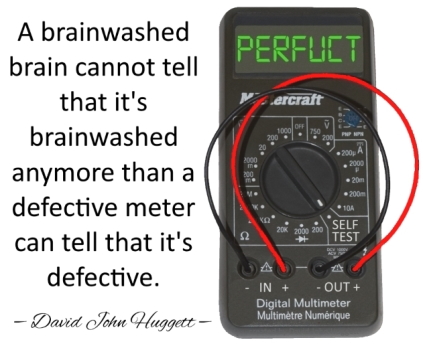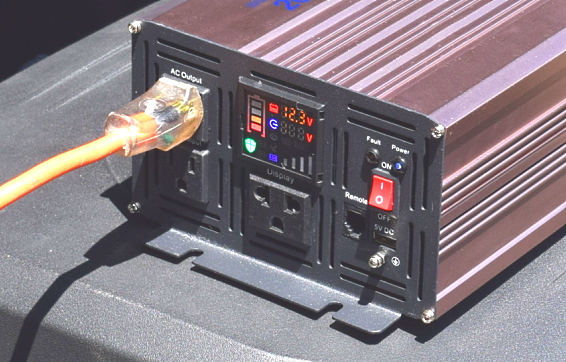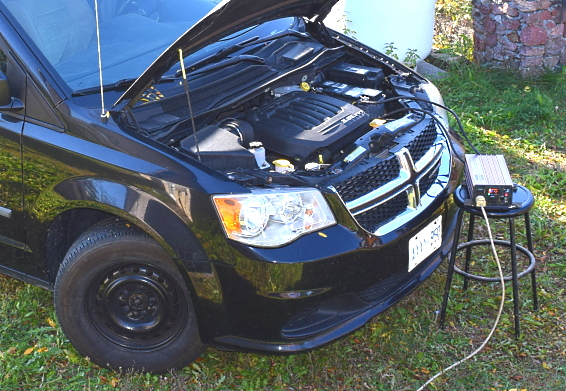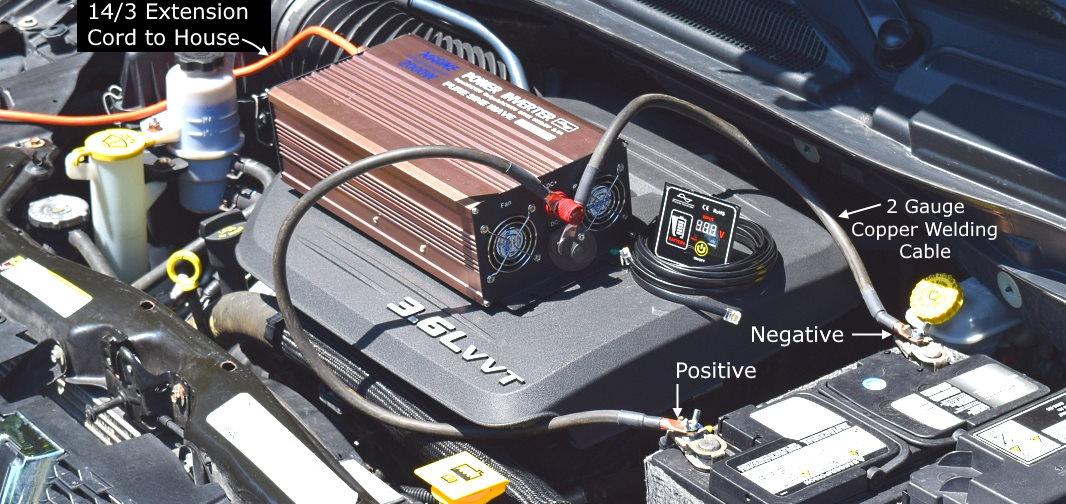
Power Your Home With Your Car
BUT - The ultimate way to power your house would be with a Tesla Solar Powerwall and Solar Array System, or with an Electric Vehicle equipped with a built-in output inverter, (V2L - Vehicle To Load) expected to be an option in the future or even standard on some vehicles like the Tesla Cybertruck or the Ford Lightning, see the Electric Vehicles page.
Right is another way to get 120v AC, if you also have a dedicated space and a spare battery. This way has the advantage of readily available power and is handy if you experience frequent blackouts. The orange wire (going up) is an old extension cord with the ends cut off and alligator clips attached. One end clips onto the spare battery and the other goes outside and clips onto the car battery. This wire doesn't have to be as thick as the "inverter to battery" cables as it's just used as a charging wire here and only necessary to keep the battery charged for an extended blackout. See the Household Tips & Tricks page to connect a solar charged battery to emergency LED lighting.
There are two main types of inverters, "Pure Sine Wave" and "Modified Sine Wave". The Modified ones are cheaper and will work with most electrical equipment although a buzzing sound may be heard with some devices. Electronic devices and DC wall chargers may work improperly or not at all. If you're on a budget and/or just require rare or occasional use, these should suffice within the above limitations. If you want, and can afford the best, then get a Pure Sine Wave inverter, especially as mentioned above, the prices are dropping. It transforms electricity to closely resemble that of your household current or a generator and it should work properly and more efficiently with all of your electronic and other devices.
Inverter versus Generator (pros and cons)
If you require large amounts of power (over 3000 watts) and/or don't have a vehicle nearby then a generator is your only choice. The larger generators also have a 240v outlet which is the best way to hook up a house or cottage for longer durations. For intermittent power outages, both work well but a generator always gives a pure sine wave, the same as your household Hydro, so we'll compare it to a Pure Sine Wave inverter.
A gasoline generator is usually much noisier (and smokier) than a modern gasoline car idling and it can even use more gas. It will have to be taken from storage somewhere and the gas will have to be added or checked for "freshness". If stored for a long time the gas may have become "stale" and it may be difficult to start. When being used, a generator will have to run at full speed (3600 rpm) to generate 60 Hz alternating current, even if a small load is being drawn.
But, with most homes, the car is in the driveway, easy to start with fresh gas in the tank. The inverter is small and easily stored on a basement shelf. It can easily be connected to a car's battery, especially if you've already done it before and have the correct cables and nuts handy.
Both systems require an extension cord to be plugged into the unit and run into the house. The car only needs to idle to charge the battery. If the car's computer senses the battery being discharged too quickly, it will speed up the motor just enough to allow the alternator to charge at full capacity. Most of the time we use electricity with varying loads, turning on and off different devices when needed. This works well with an inverter and an idling vehicle. The battery acts as a storage sink. If we draw too much for a short time, (with a larger inverter) the battery's charge may start to drop but it will re-charge back again when the extra load is turned off.
Of course a generator also works with varying loads but the cheap ones must always run at full (noisey) speed even without a load. The more expensive ones (with auto idle) will still run at full speed if there is any load at all.
Another advantage of purchasing an inverter is that you can easily and inconspicuously keep it in your vehicle for household 120v power wherever you take your ICE* car or truck.
After listening to many close-minded, and indoctrinated people, groups and cults, I realized that no amount of logic, reason or intelligent presentations of provable facts was going to change their minds. That's what inspired the above meme, with my quote and "paint-shopped" meter - from the previous picture.
As Mark Twain has been paraphrased,
"It is easier to fool people than to convince them that they have been fooled."
"If you've been brainwashed against something, you will always find the bad in it, even if it's not there." D. J. Huggett
If the above piques your curiosity, you may wish to Google the Dunning-Kruger effect.
"You've always had the power my dear,
you just had to learn it for yourself."
Glinda

Since 2012, with my Dodge's 160 Amp alternator, a full tank of gas and the engine idling, my 1500W (Modified Sine Wave) inverter ($130 on sale at Canadian Tire) could power my house (just the basic necessities, of course) for about a week.
But in 2022 the Pure Sine Wave Inverters (explained below) with higher wattages came down in price so I bought a 2000W one (under $270 CDN, $200 USA on Amazon), shown connected, above. (with the Remote Switch and 16' cord sitting beside for illustration) It works well in this location if the outside temperature is cold, but as the engine compartment creates a lot of heat, it's usually best to park in the shade and place the inverter away from the engine where it can cool more efficiently (below right). This would be required on a hot summer day, especially if your only available parking spot is in the sun, which I don't recommend.
*ICE = Internal Combustion Engine
If you have a 3000W inverter, you'll need even thicker, more expensive 1/0 or even 1/00 wire. The thicker the better - to a point. The bolt holes will be larger and may need washers and if you draw too much power for too long, it could be damaging to your battery and maybe even your alternator. Two batteries (or more) would be better and then we get into more complex and expensive systems. A 2000W inverter with 1 AWG (gauge) wire is a good compromise for this application.
Run a heavy duty extension cord (14ga+) from the inverter into your home to a power bar and plug in your necessary items. Don't draw more power than the inverter is rated for, i.e. unplug the fridge when using the microwave, unplug (turn off) both when hooked up to your gas or oil furnace, etc.. This was done by me in the Northeast Blackout of 2003 and by my brother in Toronto during the December 2013 North American Storm and it could have been done by thousands of others who had a vehicle in their driveway, this knowledge (with inverter) and a modicum of resourcefulness.

All Inverters connect to your car's battery with cables, often sold separately. Mine came with 4 gauge cables but they are too thin for heavy or extended use so here I'm using 2 gauge wire which I made-up years ago from extra welding cable and 3/8" soft copper tubing that I fabricated for the ends. I recommend buying 1 gauge cables (which come in red and black on Amazon) and use the shortest length that fits. They easily attach to
I'm keeping the car well maintained for as long as I can so I can sell a smaller proportion of my Tesla shares to buy a new Model Y or Cybertruck.

































